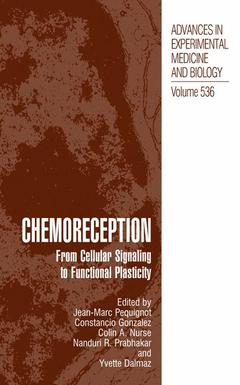Description
Chemoreception, Softcover reprint of the original 1st ed. 2003
From Cellular Signaling to Functional Plasticity
Advances in Experimental Medicine and Biology Series, Vol. 536
Coordinators: Pequignot Jean-Marc, Gonzalez Constancio, Nurse Colin A., Prabhakar Nanduri R., Dalmaz Yvette
Language: English
Subjects for Chemoreception:
Keywords
Calcium; NADPH; RNA; cells; neurons; pathophysiology; physiology; smooth muscle; tissue; transcription
Chemoreception
Publication date: 11-2012
633 p. · 17.8x25.4 cm · Paperback
Publication date: 11-2012
633 p. · 17.8x25.4 cm · Paperback
Chemoreception: from cellular signalling to functional plasticity
Publication date: 10-2003
640 p. · Hardback
Publication date: 10-2003
640 p. · Hardback
Description
/li>Contents
/li>
Since 1959, the International Society of Arterial Chemoreception (ISAC) has organized in a variety of countries fifteen scientific meetings devoted to the mechanisms of peripheral arterial chemoreception and chemoreceptor reflexes. After the meeting held in Philadelphia with Sukhamay Lahiri as president, ISAC membership elected Lyon (CNRS, University Claude Bernard, France) as the site of the xv" ISAC Symposium. The Symposium was effectively held in Lyon from the 18th to the 22nd of November 2002 and Jean-Marc Pequignot was its president. The organizers were Jean-Marc Pequignot and Yvette Dalmaz Lyon (CNRS, University Claude Bernard, France) and the Scientific Committee was formed by John Carroll (University of Arkansas for Medical Sciences, USA), Constancio Gonzalez (University of Valladolid, Spain), Prem Kumar (University of Birmingham, U. K. ), Sukhamay Lahiri (University of Pennsylvania, Philadelphia, USA), Colin Nurse (McMaster University, Hamilton, Ontario, Canada), and Nanduri Prabhakar (Case Western University, Cleveland, Ohio, USA). The Symposium in Lyon intended to follow the path opened in Philadelphia gathering people working at the interface of cellular and molecular biology with researchers in the more classical topics of chemoreception pathways and reflexes. The aim was to join experts with different perspectives. Along these lines, some participants are engaged in the exploration of the intimate mechanisms of oxygen sensing and cellular responses, with their work centered in a great number of preparations covering a broad spectrum from bacteria, to chemoreceptor cells or to central nervous systems neurons.
Honoring Pierre Dej ours His Contribution to the Study of the Role of the Arterial Chemoreceptors in the Regulation of Breathing in Humans.- O2 and CO2 Sensing Mechanisms in the Peripheral Arterial Chemoreceptors: Membrane Properties, Intracellular Metabolic and Genomic Events.- O2 and CO2 Sensing Mechanisms in Airway Chemoreceptors, Pulmonary Artery Smooth Muscle Cells and Other Oxygen-sensing Systems: Membrane Properties, Intracellular Metabolic and Genomic Events.- Mechanisms of Communication Between Chemosensory Cells and Chemoafferent Fibers.- Brainstem O2 and CO2 Sensing — Central Integration of Peripheral Chemosensory Inputs.- Plasticity of Chemosensitivity Processes During Development: Transition at Birth and Delayed Effects.- Plasticity of Chemosensitive Processes: Acclimatization to Intermittent Versus Chronic Hypoxia in Adult.
© 2024 LAVOISIER S.A.S.
These books may interest you

Oxygen SensingMolecule to Man 105.49 €



